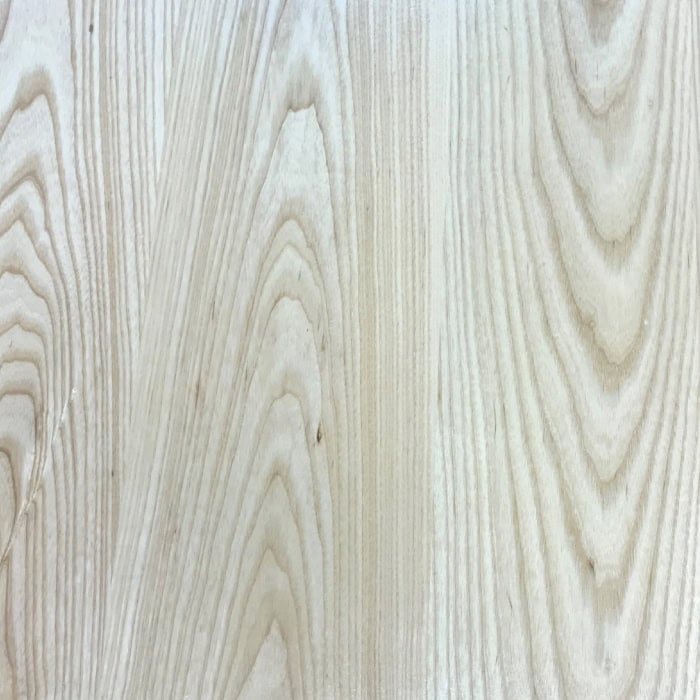Looking for a light-toned hardwood with striking grain and everyday durability for your kitchen? This guide answers the question many buyers ask what is ash wood? and shows how it compares with other popular types of wood, so you can choose the perfect wooden worktop.
What Is Ash Wood?
What Is Ash Wood? Quick Definition & Origin
1. Ash Wood Botanical Profile
Ash is the common name for timbers from the Fraxinus genus. In Europe, European ash (Fraxinus excelsior) is widely used; in North America, white ash (Fraxinus americana) is the best-known. Both yield pale, strong hardwood with a bold, flowing grain that finishes beautifully, ideal for contemporary kitchens.
2. European vs American Ash Wood
If you are weighing up what is ash wood? in practical terms, both species are similar in look and strength. European ash tends to show vivid cathedral grain and creamy to straw hues; American white ash is often a touch lighter and slightly more uniform. Premium boards (including decorative “olive ash” with darker streaks) bring extra character for feature pieces like breakfast bars.

What Is Ash Wood? Quick Definition & Origin
1. Ash Wood Botanical Profile
Ash is the common name for timbers from the Fraxinus genus. In Europe, European ash (Fraxinus excelsior) is widely used; in North America, white ash (Fraxinus americana) is the best-known. Both yield pale, strong hardwood with a bold, flowing grain that finishes beautifully, ideal for contemporary kitchens.
2. European vs American Ash Wood
If you are weighing up what is ash wood? in practical terms, both species are similar in look and strength. European ash tends to show vivid cathedral grain and creamy to straw hues; American white ash is often a touch lighter and slightly more uniform. Premium boards (including decorative “olive ash” with darker streaks) bring extra character for feature pieces like breakfast bars.


History of Ash Wood
1. Ancient and Medieval Uses of Ash Wood?
Ash wood has been prized since antiquity for its long, straight, resilient timber. It made spear shafts in the classical world, tool handles across Europe, and coach frames in the Middle Ages because it bends without breaking. Folklore even casts the world tree Yggdrasil as an ash, testament to the species’ cultural staying power.
2. 20th Century to Now
In modern times ash became the go to for hockey sticks, oars and formerly baseball bats, thanks to its shock resistance. Additionally, for kitchen buyers wondering if ash kitchen worktops, today it is a design-forward choice that brings Scandinavian brightness and a distinctive grain pattern to minimalist and shaker spaces alike.
History of Ash Wood
1. Ancient and Medieval Uses of Ash Wood?
Ash wood has been prized since antiquity for its long, straight, resilient timber. It made spear shafts in the classical world, tool handles across Europe, and coach frames in the Middle Ages because it bends without breaking. Folklore even casts the world tree Yggdrasil as an ash, testament to the species’ cultural staying power.
2. 20th Century to Now
In modern times ash became the go to for hockey sticks, oars and formerly baseball bats, thanks to its shock resistance. Additionally, for kitchen buyers wondering if ash kitchen worktops, today it is a design-forward choice that brings Scandinavian brightness and a distinctive grain pattern to minimalist and shaker spaces alike.
Characteristics & Performance of Ash Wood
1. Grain, Colour & Grade
Freshly machined ash ranges from pale cream to light honey; sunlight will gently warm it to a golden tone. The grain is usually straight and open-pored, producing dramatic cathedral arcs and occasional ripple or “tiger” effects. Select grades give a cleaner, even canvas; character grades celebrate knots, colour variation and natural features.
2. Strength, Hardness & Stability
So what is ash wood? In numbers: typical Janka hardness is ~1,320 lbf (similar to oak), with excellent elasticity and shock resistance. Movement is moderate, like most hardwoods, ash expands and contracts with humidity, so correct installation, ventilation, and regular oiling are important in kitchens.
3. Workability & Finishing
Ash machines cleanly, glues well and holds screws firmly. Its open pores accept oils and stains evenly, letting you steer the look from pale Scandi to richer honey tones. Edges route crisply for profile details; end grain takes a high polish with patient sanding.
Pros and Cons of Ash Wood
Advantages of Ash Wood
- Bright, airy colour that lightens rooms
- Bold grain adds natural texture without visual clutter
- Tough, resilient timber that resists denting in everyday use
- Excellent to machine, shape and steam bend
- Finishes beautifully with hardwax oil or lacquer; stains evenly for tailored tones
- Strong value versus premium exotics
Disadvantages of Ash Wood
-
Pale surface can highlight spills and needs prompt wiping
-
Open pores may trap fine dust unless well sealed
-
Moderate movement requires careful fitting and periodic re oiling
-
Not as naturally oily or moisture resistant as iroko or teak

Pros and Cons of Ash Wood
Advantages of Ash Wood
-
Bright, airy colour that lightens rooms
-
Bold grain adds natural texture without visual clutter
-
Tough, resilient timber that resists denting in everyday use
-
Excellent to machine, shape and steam bend
-
Finishes beautifully with hardwax oil or lacquer; stains evenly for tailored tones
-
Strong value versus premium exotics
Disadvantages of Ash Wood
-
Pale surface can highlight spills and needs prompt wiping
-
Open pores may trap fine dust unless well sealed
-
Moderate movement requires careful fitting and periodic re oiling
-
Not as naturally oily or moisture resistant as iroko or teak


Best Uses of Ash Wood in the House
Ash Wood for Kitchen Worktops
Full stave ash worktops are one example of Ash worktops, and deliver a bright, modern look that pairs with both painted cabinets and natural schemes. Use generous, continuous staves for a clean, furniture-grade feel; consider character grade for more texture. Around sinks and hobs, add extra coats of oil and maintain a dry wipe habit for long-term stability and colour richness.
Furniture, Flooring & Joinery
Designers asking what ash wood is often choose it for dining tables, shelves, stair parts and interior doors. It is strong for slim profiles, takes joinery details gracefully, and, on floors, brings lively grain that hides day-to-day scuffs better than flat-grained pale species like maple.
Best Uses of Ash Wood in the House
Ash Wood for Kitchen Worktops
Full stave ash worktops are one example of Ash worktops, and deliver a bright, modern look that pairs with both painted cabinets and natural schemes. Use generous, continuous staves for a clean, furniture-grade feel; consider character grade for more texture. Around sinks and hobs, add extra coats of oil and maintain a dry wipe habit for long-term stability and colour richness.
Furniture, Flooring & Joinery
Designers asking what ash wood is often choose it for dining tables, shelves, stair parts and interior doors. It is strong for slim profiles, takes joinery details gracefully, and, on floors, brings lively grain that hides day-to-day scuffs better than flat-grained pale species like maple.

Ash Wood Care & FAQs
Is Ash Durable for Busy Kitchens?
Yes. With correct installation, stable indoor humidity and periodic oiling, ash stands up well to daily chopping, sliding pans and family life. Use trivets for hot pots and chopping boards for knives to keep the surface pristine.
How Do You Maintain an Ash Worktop?
Oil generously before first use, then re-oil more often in the first three months while the pores saturate. After that, top up when water stops beading or the surface looks dry, typically every few months. Wipe spills promptly, avoid standing water, and refresh the finish with a light de-nib and oil when needed.
Is Ash Sustainable?
Yes. Ash is available from responsibly managed European and American forests, where replanting and careful woodland management help maintain long-term supplies. Certification schemes such as FSC and PEFC ensure that timber is legally and sustainably sourced. While regional pests such as the emerald ash borer in North America have affected some stocks, reputable suppliers continue to prioritise sustainable harvesting practices.
How Does Ash Compare to Oak for Worktops?
Ash and oak are similar in strength and durability, but they differ in appearance. Ash has a paler tone and more dramatic grain pattern, making it popular for bright, contemporary kitchens. Oak is slightly warmer in colour and has a more traditional look, which many people associate with farmhouse and heritage interiors. For a timeless choice, many customers also consider oak worktops, which remain one of the most versatile options for both classic and modern kitchen designs.
Does Ash Darken Over Time?
Yes. Like most hardwoods, ash naturally matures in colour. Freshly cut ash starts very pale but gradually deepens into a warmer golden tone, especially when exposed to natural light. Regular oiling will enhance this mellowing process and help bring out the grain’s natural character.
Why wait, order your Solid wood worktop today!
We know wood, and because of this, we are able to offer you an expansive collection of wood worktops and services, to suit any and all home projects.


